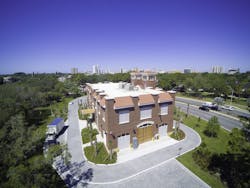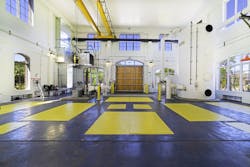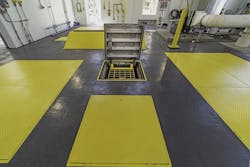WEB EXCLUSIVE: Sarasota Completes Long Road to New Lift Station
Sarasota Bay is one of Florida’s most precious water jewels. It is the largest and deepest coastal bay between Tampa Bay and Charlotte Harbor, and the U.S. Congress designated the lagoon off of Florida’s central west coast as an estuary of national significance. There are more than 4,000 acres of seagrass beds in the bay, and provide habitat for marine life, stabilize sediment and capture about 27 million tons of carbon each year.
Dolphins and manatees are among the abundant marine life in and around Sarasota Bay. It is also home to a variety of plants and creatures including nesting turtles and exotic bird species, such as roseate spoonbills, white pelicans and black skimmers. The 150-mile watershed area is a tourism gold mine. Fishing, kayaking and canoeists all enjoy spending time on the bay, helping account for more than 2.2 million visitors per year and $2.24 billion in total economic impact to county. Ecologically and financially, the importance of Sarasota Bay cannot be overstated.
Sewage spills are unwelcome anywhere, but especially near Sarasota Bay. “The overall health of the bay has regressed in many ways over the past decade,’’ Orion Morton, a kayak tour guide and advocate for Sarasota Bay wrote in the Herald-Tribune newspaper in April. “We have become accustomed to sewage leaks.”
Morton said over the past few years, millions of gallons of untreated waste have been released into Philippi Creek, and Longboat Key experienced a sewage pipe leak last summer. Both tributaries connect to Sarasota Bay.
Lift Station 87, which came online in the fall of 2020, will help solve Sarasota’s sewage spillage issues. The station will replace Lift Station 7, which was commissioned in the 1980s but reached the end of its useful life by 2004. That year, more than 500,000 gallons of raw sewage seeped into the Hudson Bayou, another Sarasota Bay tributary.
The new lift station will manage about 33% of the city’s wastewater flow when all of the community connections come online, which is expected to occur by the end of July 2021. Sarasota city officials are counting on Lift Station 87 to stop sewage leaks that contribute to the declining health of Sarasota Bay. The path toward completing the project, however, was unduly lengthy – and costly.
“This has just been a nightmare of a project,’’ Commissioner Liz Alpert told the Palm Beach Post in May 2020.
Foul Odors
Almost from the outset after Lift Station 7 was constructed in the 1980s, neighbors complained about foul odors to the city’s public works department. Political leaders, however, had been largely unaware of the issue.
The spill in 2004 was followed by another 500,000 gallon spill in February 2005. That is when residents first learned of the 2004 spill. Michael McNees, Sarasota’s City Manager at the time, drew the ire of residents when he defended city employees. In August of 2005, six employees of the public works department were reprimanded, demoted or forced to retire. By 2007, McNees had resigned, in large part due to community pressure over his handling of the failing lift station.
In 2008, the city approved the relocation of Lift Station 7 from Pomelo Avenue to Luke Wood Park. The state Department of Environmental Protection imposed a 2011 deadline for the city to move the station from Pomelo Avenue. The park was considered the most cost-effective and time-efficient solution, while some neighbors asked for other solutions.
The city estimated the cost of the new facility at $8.5 million. The city awarded Westra Construction Corporation a $9.6 million contract in February 2011, and work began in June with an estimated completion date in 2012. AECOM served as the project engineer.
Construction began in June 2011, but another spill resulting from construction alarmed residents and city officials. In August, a contractor accidentally broke a 14-inch force main, causing an estimated 200-gallon sewage spill into the Hudson Bayou. AECOM and Westra were fired, stopping work on the project. Seven years after the first 500,000 gallon sewage spill into the Hudson Bayou, the city was no closer to fixing the problem.
Moving On
With its engineering and construction teams ousted, Sarasota returned to square one to construct its new lift station. McKim & Creed took over as the project engineer, and made two critical recommendations.
One change McKim & Creed planned was to construct a lift station that could withstand Category 3 hurricane storm surges. The region, on Florida’s Gulf Coast, has been impacted by hurricanes 36 times over the past 150 years. Two storms hit Sarasota in 2017, including Hurricane Irma. The Category 2 storm brought on fallen trees and power outages with a reported cleanup cost of $8 million.
Another issue concerned the Osprey Avenue Bridge over the Hudson Bayou. The potential of another sewage spill if Westra had continued work could have been catastrophic, as workers were on the verge of drilling into the northern support slab of the bridge, according to a report. “We’re very lucky we didn’t have a catastrophe with our utility department,’’ then-Mayor Shannon Snyder said in 2014.
McKim & Creed planned to construct a 670-foot microtunnel below the bridge. It needed to be placed eight feet further down to avoid impacting the structural integrity of the bridge, as engineers believed the bridge might have collapsed in the soft silt base. Environmental considerations also required a deeper microtunnel.
“The invert elevation of the 36-inch main was lowered 8 feet to avoid interference with existing bridge abutment and to minimize potential impacts to the environment during drilling,’’ McKim & Creed wrote on its website. “Phase 1 also included a review of the previous lift design and recommendations to increase reliability, improve worker safety and minimize operational issues.”
Dig It
McKim & Creed engineers believed microtunneling needed to be implemented due to the unstable soils under the bridge and the sensitive ecological environment. The issue with microtunneling, however, is that is extremely time consuming. Crews advance only around 20-40 feet per day.
“The only choice was to go under the bridge, and microtunneling was the only option,” McKim & Creed Project Manager Robert Garland, PE, said in a radio interview. “You’re underground, chewing through rock, under a historic bridge, and in an environmentally sensitive water,’’ he said. “We went about this in a methodical way so that we don’t cross-contaminate the bayou.”
Microtunneling is a remotely controlled process that is frequently used in soft, unstable soils. Crews dig sending and receiving pits to install a new sewer pipe. A microtunnel boring machine is dropped into the sending pit and cuts a hole underground to the receiving pit, without disturbing the surface above. A jacking rig, functioning similar to a jack hammer, pushes the new sewer pipe in place.
Wastewater is carried through a 36-inch PVC pipe in the microtunnel, and it is encased in a 60-inch casing. “We put the steel casing in first, which is the wall of the tunnel,’’ Garland said. “Inside that casing will be the pipe that carries the wastewater. It helps us in the construction, but if there is any failure of the pipe, it is contained within that casing.”
Microtunneling work began in January of 2017. “This is where the rubber meets the road,’’ Mitt Tidwell, Sarasota’s Utilities Director at the time, told the Sarasota Herald-Tribune. “We scheduled this work first to protect the city’s investment and minimize risks.” The process included the closure of the Osprey Avenue Bridge in Sarasota in July of 2016. The bridge re-opened in June 2017.
McKim & Creed said the project reduced construction risk by more than 90% from preliminary design to the final design and work was completed at 18% under the original estimate.
The project also included a 560-foot long tunnel under Luke Wood Park that connects to Lift Station 87 and with the microtunnel installed under the Hudson Bayou. Work on the microtunnels – which included a combined length of 1,230 feet with a 36-inch diameter pipeline and 60-inch diameter steel casing -- was the first item on the agenda. Sarasota city officials, and residents who dealt with road closures, construction noise, and more, breathed a sigh of relief when the tunnels were completed in June 2017.
State-of-the-art lift station
Establishing microtunnels in ecologically-sensitive areas while not impacting the structural integrity of the bridge proved to be the most vexing part of the project. That phase, however, was only the first step in the process.
In October of 2017, teams started construction of the new lift station. Work included the demolition of existing structures and the construction of a state-of-the-art odor control facility. The fully-enclosed building minimizes the impacts of routine operation and maintenance, according to the city.
The building includes HVAC and equipment exhausts in the towers, and the two-story building was built over a new, 50-foot deep wet well. It has a maximum capacity of 9.5 million gallons per day. “We’ve spent the past year constructing the equivalent of a five-story building underground and below sea level,’’ Sarasota Utility Director Bill Riebe said in a press release in August 2019. “Construction of the wet well and connection of new, micro-tunneled 36-inch gravity sewer to the wet well piping has been technically complex.”
PCL Construction installed 15 doors from BILCO in the lift station. The doors were manufactured in a wide range of sizes and allow access to vaults, pipes and pumps in the wet well. The floor doors are constructed from aluminum with stainless steel hardware for corrosion resistance and are reinforced for H-20 loading to withstand the force of heavy equipment vehicles used at the facility.
“The doors are durable, and they are a good product for this application because they are aluminum and won’t be as impacted by corrosive gases and water,’’ said Cory Westphal, an Assistant Project Manager for PCL. “It was a fairly standard installation except that they were installed before the building was finished. The building was built around the doors.”
PCL ordered the doors through Building Specialties of Bradenton, which worked with them to manufacture special sizes. “BILCO was selected because they had the capability to make very large hatches,’’ Westphal said. “Competitors had difficulty building the sizes we needed and meeting the loading requirements. The ability to make them that large and meet those requirements was essential. They were prepared because they build doors like this frequently and they knew how to do it.”
Pipeline Construction
The final phase included the installation of a 24-inch diameter gravity wastewater pipeline by open cut along Alta Vista Street and Osprey Avenue. Crews also replaced aging ductile iron and asbestos cement pipe, installed new reclaimed water mains and replaced storm sewers. New curbs, sidewalks and drainage improvements were included. Osprey Avenue, which had been closed earlier in the process for the digging of the microtunnels, was closed again from June 2020 through March 2021.
Along Pomelo Avenue, the location of Lift Station 7, and Pomelo Place crews installed an 8-inch diameter gravity sewer by open cut and replaced water mains with larger pipes. New reclaimed water mains were also installed in the area.
Wastewater flow was diverted to Lift Station 87, and Lift Station 7 will eventually be demolished and restored to a park-like setting.
Learning from its past failures to communicate with city residents, officials also maintained a website that kept people informed as the project moved toward completion.
Expenses Mount
The extended timeline, shifting plans and elaborate scope resulted in dramatic cost escalations. Originally projected to cost approximately $8.5 million in 2005, the final price will amount to about $68.5 million. That figure includes $48.6 million for planning and construction, according to YourObserver.com.
City officials had hoped to recoup as much as $20 million from legal settlements, but in November of 2018 a jury ruled the engineering firm did not have to pay any damages. The jury also said the city breached the contract with Westra, and was ordered to pay $686,233 in damages. The city paid $10.1 million in legal fees for the project, according to the news outlet.
As workers put the finishing touches on the project, Sarasota city officials and residents are hardly in a ribbon-cutting mood. The project received plenty of media attention while residents and political leaders chafed as work dragged on. City Manager Tom Barwin, who was hired in 2012 and led the city throughout much of the ordeal, retired at the end of 2020.
For city officials and residents, the project’s completion is a time for reflection, not celebration. “I think we need to own up to it and explain to the community what happened so that we and future commissioners don’t have the same problem or learn from those mistakes,’’ Commissioner Hagen Brody told the Herald-Tribune last September.
About the Author
Thomas Renner
Thomas Renner writes on building, construction, engineering and other trade industry topics for publications throughout the United States.




